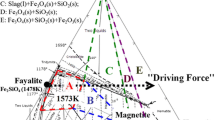Using x-ray phase, chemical, and thermal (20–1200°C) analysis methods, phase composition and thermal properties are evaluated for three specimens of quartz-containing materials used as fluxes in copper smelting production. It is established that quartz in specimens on heating to 1000–1200°C undergoes enantiothropic polymorphic transformation by a scheme: α-quartz → β-quartz → β-cristobalite. In order to evaluate the efficiency of using materials as fluxes for copper smelting production, equations are proposed for calculating fluxing capacity depending on their chemical and phase composition. A dependence is given for the amount of slag formed as a result of slagging flux impurity oxides on material phase and chemical compositions on whose basis losses of nonferrous and precious metals are evaluated. It is suggested that flux materials are heated to a temperature for the start of polymorphic transformations accompanying quartz recrystallization (~560°C) before charging into a metallurgical unit.


Similar content being viewed by others
References
A. I. Vol’khin, E. I. Eliseev, and V. P. Zhukov, Black Copper and Sulfuric Acid: Physicochemical Bases of Production, Kniga, Chelyabinsk (2004), Vol. 2.
V. Ramachandran, C. Diaz, and T. Eltringham, “Primary copper production – a survey of operating world copper smelters,” Int. Conf., Santiago (2003), Vol. 4, No. 1, pp. 3–106.
S. M. Kozhakhmetov, New Effective Processes in Pyrometallurgy of Copper, Nickel, and Gold, TsNIZMO, Almaty (2015).
A. V. Vanyukov and N. I. Utkin, Combined Processing of Copper and Nickel Raw Material: Textbook, Metallurgiya, Chelyabinsk (1988).
E. N. Selivanov and V. V. Belyaev, “Interphase distribution of copper and associated metals during conversion of copper matte,” Tsvet. Met., No. 8, 18–23 (2004).
V. A. Zverev, E. V. Krivopustova, and T. V. Tochilina, Optical Materials: Textbook, SPb NIU ITMO, St. Petersburg (2012), Pt. 2.
H. A. Wrledt., “The O–Si (oxygen–silicon) system: alloy phase diagram evaluation,” Bull. Alloy Phase Diagr., 11, No. 1, 43–61 (1990).
A. V. Shamshurov, “Clarification of temperature limits for existence of polymorphic modifications of quartz under direct recording conditions,” Proc. Int. Conf. Crystallogenesis and Mineralogy, St. Petersburg, Oct. 1–5, 2007, pp. 140–142.
N. Zulumyan, A. Mirgorodski, A. Isahakyan, and H. Beglaryan, “The mechanism of decomposition of serpentines from peridotites on heating,” J. Thermal Anal. Calorim., 115, No. 2, 1003–1012 (2004).
S. R. Gzogyan and E. L. Chanturiya, “Effect of thermal action on iron sulfides and oxides,” Gorn. Inform. Anal. Byull., No. 5, 63–69 (2010).
A. D. Vershinin, E. N. Selivanov, and A. L. Danilushkin, “Thermal expansion and decomposition of FeS2–x and CuFe2–x ,” Neorgan. Mater., 34, No. 12, 1423–1427 (1998).
M. R. S. Swamy, T. P. Prasad, and B. R. Sant, “Thermal analysis of ferrous sulphate heptahydrate in air. Part I. Some general remarks and methods,” J. Thermal Anal., 15, No. 2, 307–314 (1979).
N. N. Emel’yanova, N. V. Zayakina, and G. N. Gamyanin, “Thermal and x-radiographic study of quartz of precious metal deposits of Yakutia,” Proc. All-Russ. Sci.-Pract. Conf. Geology and Mineral Resources of the North-West Russia, SVFU, Yakutsk (2015), pp. 157–160.
NPCS Board of Consultants and Engineers, The Complete Technology Book on Minerals and Mineral Processing, Asia Pacific Business Press Inc. (2008).
Yu. V. Popov and Zh. S. Kobzareva, Main Methods of Field Study and Laboratory Analytical Study of Sedimentary Rocks, RGU, Rostov-on-Don (2006).
N. P. Tabunshchikov, Lime Production, Khimiya, Moscow (1974).
V. N. Bobrov, S. M. Kozhakhmetov, and E. A. Sit’ko, “Fluxing capacity of ores and slags of copper smelting production and effect of refractory oxides,” Dokl. NAN RK, No. 3, 61–63 (2003).
V. M. Bobrov, S. M. Kozhakhmetov, and E. A. Sit’ko, “Copper smelting production fluxes,” Tsvet. Met., No. 4, 51–55 (2010).
V. M. Bobrov and E. A. Sit’ko, “Study of quartz ore decrepitation,” Kompl. Ispolz. Miner. Syr’ya, No. 3, 19–26 (2005).
This work was carried out in the framework of a State Assignment (State registration No. 01201357432) with support from the program of the Russian Academy of Sciences (Ural Division) for basic research (Project No. 15-11-3-31) using equipment of the Ural-M Collective Use Center.
Author information
Authors and Affiliations
Corresponding author
Additional information
Translated from Metallurg, No. 2, pp. 75–79, February, 2017
Rights and permissions
About this article
Cite this article
Selivanov, E.N., Klyushnikov, A.M. & Gulyaeva, R.I. Use of Quartz-Containing Materials as Fluxes in Copper Smelting Production. Metallurgist 61, 155–161 (2017). https://doi.org/10.1007/s11015-017-0469-x
Received:
Published:
Issue Date:
DOI: https://doi.org/10.1007/s11015-017-0469-x




